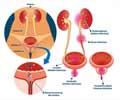For World Standards Day 2011 Medindia discussed healthcare standards in India with Ms. Rama Venugopal, Executive Director, Value Added Corporate Services, based in Chennai, South India.

Q. Tell us the role your company plays in establishing high standards in healthcare industry?
A. As a consulting organization we facilitate organizations in the health-care industry to implement and establish best clinical and administrative practices. Over the years we have facilitated a number of hospitals, laboratories, imaging centers, blood banks to implement and establish systems and practices conforming to national/international standards like NABH, ACHSI, CAP, NABL leading to quality patient care services. We facilitate organizations to set highest level of quality that is required to meet the international standards. We do that by educating and training staff on the importance of quality and effectiveness in implementation of international standards.
Q. Can you tell us about the awareness levels on standards in India and willingness levels to implement these standards in hospitals & diagnostic centers?
A. Awareness level on the standards has increased drastically over the last couple of years due to demand for standards from bodies like Central Government Health Scheme (CGHS) and the Insurance sector.Nowadays healthcare organizations are keen on implementing the standards. Public awareness level is high as the knowledge regarding national and international standards are more commonly projected in media now than before. Also the current boom in medical tourism has increased the foreign patient population and the organizations are competing to provide high standards and quality care. Also it provides opportunity to benchmark with the best.
Q. Why are standards very necessary for healthcare industry?
As per 2006 study in Indian council for research on international economic relations in India, the estimated loss in India’s national income as a result of heart diseases, stroke and diabetes in 2005 was US$9 billion, and this is projected to exceed US$200 billion over the next 10 years. Firms lose approximately 14 percent of their annual working days due to sickness.
Q. How do hospitals/diagnostic centers benefit through standards?
A. Implementing well defined systems and processes in accordance with international benchmarks ensure that we bring consistency in healthcare delivery. It will minimize the scope and opportunities for errors/mistakes through the medium of continuous monitoring as well as greater awareness created through training programs. Hospitals/diagnostic centers benefit through standards by Reducing error rates, rework and waste, customer dissatisfaction.
By following standards, hospitals/diagnostic centers can increase their yield, capacity and improve their delivery performance. A well defined system will involve all the people in the healthcare delivery which includes patients, doctors, nursing staff, paramedics, bio-medical engineering and administration to name a few. In the long run once the standards gets internalized the benefits will become more pronounced and even effective commercially. In that context implementing standards should be seen as an investment and not a cost.
Implementing these standards in a health care organization stimulates continuous improvement and enables the organization in demonstrating commitment to quality care. It has the potential to improve the community confidence in the services provided by the health care organization as it facilitates access to reliable and certified information on facilities, infrastructure and level of care. It would also go a long way in the hospitals getting international recognition also. This will provide boost to medical tourism.
The standards provide framework for quality assurance and quality improvement for hospitals, focus on patient safety and quality of care, make available a system of continuous monitoring of sentinel events and comprehensive corrective action plan which lead to building of quality culture at all levels and across all the functions.
Q. How does a common man benefit through standards?
A. The common man will get high quality of care and safety and services by expert medical staff. Rights of patients are respected and protected. Evaluation of Patient satisfaction is done regularly. Since the hospitals following standards will have high quality of services and care, the patient gets very good care at an affordable cost.
Some of the key tangible benefits would include factors like:
• Accessibility
• Affordability
• Prompt attention
• Less waiting time
• Early diagnosis and cure
• Return to work as early as possible
• Humane Treatment –that is, to be treated with empathy, respect and concern
Q. What is infection control?
A. Infection control practices control/eliminate sources of infection and help protect patients and health care providers from disease. A patient entering health care setting is at risk for acquiring infections because of lowered resistance to infectious microorganisms, increased exposure to numbers and types of disease-causing organisms and invasive procedures. The hospital environment plays a major role in the transmission of microorganisms.
For example, potential sources of hospital cross infections are doctors’ white coats, nurses’ uniforms, contaminated hands, hospital garments, privacy drapes, stethoscopes, bed rails, and biomedical waste among others. Patients undergoing hospital treatment frequently become infected. These infections arise from many different sources and are usually associated with operative or other invasive procedures carried out in operating theatres, wards, X-ray departments and clinics. Doctors, nurses and other healthcare personnel come into contact with a variety of microorganisms and must practice infection control and techniques to avoid spreading them to patients. In order to achieve reduction in infection rates among patients and staff, an infection control program has to be developed with a clear and firm organizational structure. Without proper infection control, recovery of patient slows down leading to increase in cost of treatment and prolonged stay in hospital. Thus these factors contribute to high morbidity and increase the death rate.
Q. What is the scope of infection control? Is it restricted to Labs, Operating Theatres & ICUs?
A. In India, one in five patients admitted to hospital acquired Healthcare Associated Infections (HAI) a decade ago. HAI includes urinary tract infections, ventilator associated pneumonia and centraline related blood screen infections. It is believed to cause complications between 3.5% and 16.6% patients worldwide. Most common types of HAIs are surgical wounds and lower respiratory tract infections that are found among patients admitted to ICUs, labour rooms and among patients undergoing invasive procedures or those on immunosuppressive drugs. So the scope is of wide range.
Since Labs, OT and ICU’s are critical/high risk areas the monitoring will be more. It can be expanded to CSSD (Central sterile supply dept,) Blood bank, HDU (High dependency unit) etc based on the scope of HCO.
Q. What are the types of standards that help in infection control?
A. All national and international standards promote infection control and emphasis its importance. For example the National Accreditation Board for Hospitals and healthcare providers (NABH) standard in India focuses on this aspect through a separate chapter Hospital Infection Control (HIC). It covers various issues related to infection control like introducing dedicated HIC team to monitor hand hygiene/ hand washing, cleaning/disinfection/sterilization, vaccination, surveillance etc.
OHSAS 18001 (Occupational Safety & Health management systems) provide a framework for a safe and healthy working environment. The benefits are:
• Providing a safe working environment
• Delivers cost savings by minimizing risks to employees
• Improved operational efficiency
Q. How do these standards help in infection control?
A. Infection control is gaining widespread attention in all healthcare settings. Incorporating an infection control program is essential to minimizing the incidence of infection and patient revisits.
As a part of implementing these standards the health care organization will start monitoring the infection control aspects such as hand hygiene, biomedical waste management, infection rate surveillance etc. It will support hospitals in reducing the risk of health-care-associated infections. Health Care Organization (HCO) will also introduce the best infection control practices through international guidelines such as CDC, (Centre for Disease Control) guidelines for infection control, WHO (World Health Organization) etc.
As a part of these environmental control methods, reporting of communicable diseases, attention to employee heath, infection surveillance, isolation practices, validation of sterilization practices will be implemented.
Antibiotic usage in India is very high, and no regulatory mechanism has been put in place. Since the standards clearly say about Antibiotic policy, the indiscriminate use of Antibiotics will be curtailed and monitored.
Monitoring of needle stick injury rates will help in preventing the spread of blood borne disease to health care workers and can reduce those incidents by vaccination and training them in safe practices.
Source-Medindia











